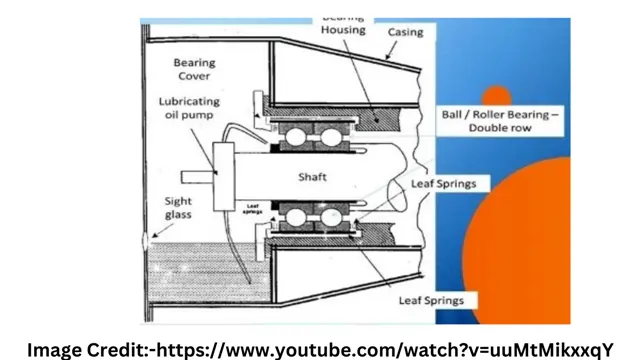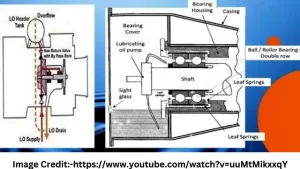Table of Contents
Turbocharger Bearing Lubrication System
To ensure the optimal performance of a turbocharger, proper lubrication and maintenance of the bearings are essential. Bearing friction is one of the leading causes of energy loss in turbochargers and should be kept as low as possible to maintain efficiency. With such high-speed rotating machinery, bearings are installed on the shaft, which moves at extremely high speeds and carries a considerable load. Particular lubricants are used that can provide adequate protection from extreme heat and pressure To minimize wear and tear on these components. Proper lubrication also helps reduce noise caused by bearing friction, so that engine operation remains smooth and quiet. Proper Lubrication of the TC bearing will prevent the Turbocharger failure
Turbo Bearing Traits
Managing Heavy Loads Effectively
The turbocharger has important parts called bearings. They need to manage a lot of pressure, especially when the engine is running. These bearings should be made from strong materials so they don’t break when under pressure. They also need good oil and cooling systems to work well for a long time.
Enduring Harsh and Challenging Conditions
Turbochargers in ships face tougher conditions than on land. They handle very hot and humid weather, plus salty water that causes rust. The bearing inside must work well even with these tough conditions. So, turbochargers and bearings need to be made strong to handle these challenges.
For any machine to work well, it needs to be reliable. That’s why the bearing in a ship’s turbocharger should work even when the engine runs for a long time or when the oil gets dirty. The bearing should be built to handle these situations and still work well. This helps the turbocharger work better and reduces unexpected breakdowns.
Decreased Temperature Spikes
When a ship’s engine starts or stops quickly, the turbocharger spins at a fast pace, making the bearing get very hot. This short burst of high temperature can be a problem. The bearing needs to be designed to handle these sudden temperature spikes. This is important because if the bearing can’t handle it, it might get damaged, causing the turbocharger to not work well. So, engineers make sure the bearing is strong enough to manage these hot moments without any issues. This way, the turbocharger keeps working smoothly, even when the engine abruptly starts or stops.
Lubricating Oil Compatibility
The material of the bearing should not cause a reaction with the oil that’s used to keep the turbocharger and other parts working smoothly. This is important because if there’s a reaction, it could damage the bearing or other components. So, engineers choose a bearing material that plays nicely with the oil and won’t cause any trouble. This way, everything keeps running well without any issues.
Managing High Thrust Loads
The bearing needs to work well even when there’s a lot of force pushing on it, which we call high thrust loads. While some bearings are great at handling high speeds, they can struggle when there’s a lot of force involved at lower speeds.
A big problem that can happen to bearings is when they break suddenly. This usually occurs when too much force is put on one side of the bearing’s shaft all at once. This can cause parts of the bearing to break apart, leading to the whole thing failing right away.
Engineers have to make sure the bearing is tough enough to handle these strong pushes without breaking. They need to choose the right materials and designs to keep the bearing working smoothly even when there’s a lot of force on it.
Oil Delivery with Delay Tolerance
In certain cases, turbochargers don’t have their own oil containers or pumps for the bearings. Instead, they get oil from the main engine system through long tubes, and it takes time for the oil to reach the bearings after starting. The bearings must work well even if there’s not a lot of oil at the beginning. This means they need to be designed to tolerate a delay in getting enough oil. So, engineers make sure these bearings can handle running with less oil until it reaches them. This way, the turbocharger keeps working fine, even when the oil takes some time to get where it’s needed.
Types of Turbocharger Bearings
Ball-type bearing (rolling type)



Ball-type bearing arrangement is usually provided on the Blower side of the turbocharger. The inner race of the bearing is firmly fixed to the shaft. Leaf springs are mounted axially and longitudinally between the outer race and the bearing housing.
Leaf springs dampen vibrations and reduce the chattering of steel balls or rollers, thereby extending bearing life.
The bearing is completely enclosed in the housing, the bottom of which forms a lubrication sump. A gear pump driven by the turbine shaft draws oil from the sump and delivers a jet of oil to the bearings.
The housing has a sight glass for checking the oil level, oil filler, and a drain plug. Blower end bearings also position the T/C rotor assembly and absorb axial thrust axially.
Turbine end bearing and lubrication arrangements are similar, except that this bearing is a single row, and the arrangement allows for thermal expansion of the rotor shaft.
This lubrication system is used in axial T/Cs where the bearing mount is on the outboard, and the rotor is on the inboard. This arrangement includes a self-contained gear pump driven by the turbine shaft. A separate bearing sump draws oil and feeds it under pressure to the bearings.
Ball bearings or roller bearings can be used as bearings.
Pros
- Because the pump is located at the end of the shaft, inspection, and maintenance are easy.
- No additional internal parts, such as separate sumps, coolers, or filters, are required.
- Choice of lubricating or turbine oil.
- Low cost of acquisition.
- Better lubrication at higher speeds.
- It reduces friction losses at high speed.
Cons
- Poor lubrication when starting or at low speed.
- Bearing friction from vibration can cause static waviness (If there is oil starvation).
- Oil should be changed regularly.
- Finite the life of the pump.
- Additional costs will be incurred for LO grade other than system oil.
- A failure of the connected pump will severely damage the T/C.
Sleeve type Bearings



Sleeve-type bearings are great for turbochargers to work well and last. They get oil from an outside system. This system uses gravity to send oil from a tank above, or a pump can be used. This way, there’s always enough oil for the bearing to stay smooth and not get damaged over time. If the bearing breaks, it’s also easy to replace. In this way, you can save money and keep the Turbocharger in good shape.
Sleeve Bearing Lubrication system



The turbocharger rotor is guided in the radial direction through 2 floating bearing bushes(4) arranged between the turbine wheel and compressor wheel in the bearing casing. The locating bearing (5) on the compressor side serves both for axial positioning and for taking the axial thrust.
The turbocharger bearings are lubricated by the lube oil circuit of the engine via a common feed pipe (2). The lube oil serves well for the cooling of the bearings.
The turbocharger must be lubricated after the engine stops with a lube oil pressure of min—0.3 bar To cool the plain bearings. The engine lube oil pump or the auxiliary pumps must continue running for 10 to 30 minutes.
Pros
- Continuous lubrication is possible.
- No separate oil is required, and system oil can be used.
- Reduces the possibility of static brinelling between the shaft and bushing/sleeve due to the presence of the L.O. film.
- A backup tank is available in case the primary pump fails.
- L.O. does not need to be changed or updated regularly. Lubrication is efficient in all speed ranges.
Cons
- Acquisition costs are very high due to the requirements for pipes, coolers, filters, and expansion tanks.
- Elements in the pipeline can be swept away and may cause the bearings to be damaged.
- If the quality of the L.O. system deteriorates, the bearing will be damaged.
Qualities of Lubricants for Turbocharger Systems
- Handle high temperatures and stay stable.
- Synthetic, easy separation from water.
- No bad reactions with turbo parts.
- Can hold a lot of stuff.
- No foaming allowed.
- Guard against rust and corrosion.
- Let air pass through.
- High ignition point, low freezing point.
- Keep a steady thickness in different temps.
Blog Post Conclusion
To wrap up, looking after a turbocharger is super important. Keeping it working well and lasting a long time needs special care. We learned how tough turbochargers work in hard places, and their bearings need to be strong too. They have to handle strong pushes and keep going even if oil arrives late. Using the right oils is a big deal. These oils need to fight the heat, not mess with parts, and stop rust. They should also stay the right thickness in different temperatures.
Remember, a turbocharger that’s looked after can do better and save money over time. It’s a bit like taking care of your car’s engine – it helps everything work better. So, if you like engines or fix them, knowing about turbochargers and their bearings is super handy. It’s about keeping things smooth and working well. With good care and knowledge, you can make sure your turbocharger keeps spinning without any trouble!
Q: What is a turbocharger-bearing lubrication system?
A: It’s a system that provides oil to keep the turbocharger’s bearings working smoothly.
Q: Why is lubrication important for turbocharger bearings?
A: Lubrication prevents friction and wear, helping the bearings last longer.
Q: What qualities should lubricants for turbocharger bearings have?
A: They should resist high temperatures, prevent rust, and not react with the turbocharger’s parts.
Q: How does proper lubrication affect turbocharger performance?
A: Good lubrication ensures efficient and reliable turbocharger operation.
